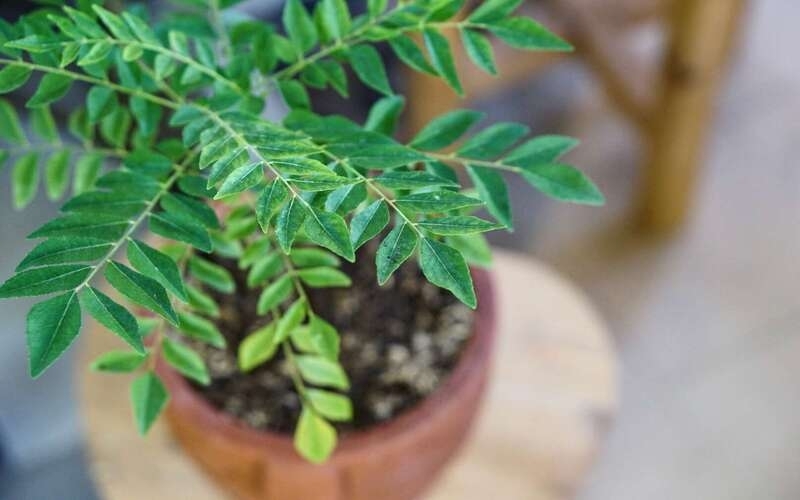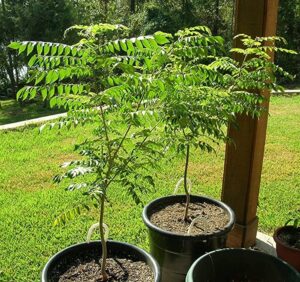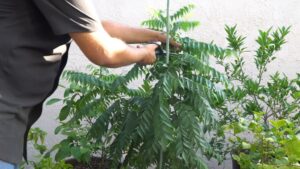Temper, Flavor and Garnish Your Dish with Fresh Curry Leaves Easily Grown at Your Home

Nursery Today Desk
New Delhi: Are you still buying curry leaves from market? Curry leaves which are dominant in every south Indian cuisine as well as popular in every other Indian dish is highly aromatic and has a very distinct taste which spices up any dish it is used in or garnish the dish. Its culinary uses are very popular, with this it also has many medicinal benefits.
Different Names of Curry Leaves
Curry leaves are also called sweet neem with a resemblance to neem leaves. It is also known as Kari Patta or Meetha Neem in Hindi, Kariveppilai in Tamil and Karivempu in Malayalam. This plant is native to India, Srilanka, and many Southeast Asian countries. ‘Kari‘, which means ‘spiced sauce’ is used as a flavoring agent for vegetables. It is recognized as the most popular spice and condiment in India.
Benefits of Curry Leaves
Curry leaves are mentioned in Ayurveda as Girinimba or Krishnanimba, named in several ancient scriptures after Lord Krishna. The essential oil extracted from the leaves of the curry leaf tree is commonly used for the treatment of hair and skin issues.
Curry leaves are a rich source of vitamin A, vitamin B, vitamin C, vitamin B2, calcium, and iron, apart from a heavy distinctive odor and pungent taste. It helps in the treatment of dysentery, diarrhoea, diabetes, morning sickness, and nausea by adding curry leaves to your meals. Often, curry leaves help flush out toxins and the fat content of the body.
Curry leaf plants are low maintenance. With some seeds, potting mix and a small pot you can start to grow your curry leaf plant. Follow the steps below to grow the curry leaves in your kitchen garden.
Ideal pot: Ideal pot for starting a curry leaf plant is of measurement 4–6 inches (10–15 cm) tall and 3–4 inches (7.6–10.2 cm) wide. In an area with climate zones 9-12 or the temperature doesn’t fall below 32 °F (0 °C), you can put your curry leaf plant directly in the ground. Make sure to amend the soil so it has proper nutrients.

Potting Mix: Mix 60% potting soil and 40% compost thoroughly to make the potting mix for enough availability of nutrients for the plant to grow. Avoid using soil from your yard, which may contain harmful bacteria instead use store-bought potting soil.
How to sow the seed: Using your thumb, push the center of the soil to make a hole of ½ inch (1.3 cm) deep. Drop a single seed of curry leaf plant into the hole and then fill the hole with some of the potting mix and cover the seed. The seeds are available online as well as in food markets.

Planting the stem of Curry leaf plant: you can also grow curry leaf plant from a fresh cutting of a larger plant. Take a cutting that has at least 2-3 leaves on it and push the stem 2-3 inches (5.1-7.6 cm) deep in the potting mix.
Selection of Location: Setting the plant near a south-facing window can get them sunlight throughout the day. If your location has the weather that’s above 32 °F (0°C), you can also place the pot outside. Make sure the plant gets full sun, or 6-8 hours, during the day, or else it won’t produce strong shoots or leaves. If your plant doesn’t get full sun throughout the day, it may drop some of its leaves and grow weak.

Watering the plant while sowing: Check the soil in the pot every other day to see if it feels dry to the touch. If it doesn’t feel moist when your finger is ½ inch into the soil, wet the soil with a watering. Water the plant till the soil fully absorbs the water and water comes out of the drainage holes at the bottom of the pot. Do not over water the plant.
Pruning: Pruning helps to keep your plant at a reasonable size and promote healthy growth of leaves. Any weak, broken, or wilted stems must be removed. Check your plant in the spring season, take notice of any tall vertical growths that aren’t supported by a lot of leaves. The top 3 inches (7.6 cm) right below one of the nodes where the leaves link should be cut off using a pair of gardening snips. To prevent your plant’s stem from beginning to decay, make your cut at a 45-degree angle.

Move the plant: Curry leaf plants continuously grow to fit the size of their container, so they need to switch pots every year. Carefully pull out the stem of the plant from its base. Plant it back in the similar way as explained earlier into a new pot that’s twice as wide as the plant’s root ball. Don’t use too large of a pot right away since the plant will put most of its energy into growing the roots.
Harvesting the leaves: After your plant gets an year old and is filled out with leaves, look where the long stem that connects multiple leaves attaches to the main body of the plant. Grip the stem by its base and lightly pull it off the plant to collect all of the leaves attached to it. You can harvest up to 30% of the plant’s leaves. If you harvest more, the plant may not grow as well the following year.
How to Store the Leaves: Curry leaves are aromatic when they are fresh. They lose a lot of their flavor when they are dried. The best way to preserve them is to freeze them.

Pluck the leaves and throw away the rotten leaves, rinse it thoroughly and dry the leaves. In the next step, preserve it in a zip-lock bag/airtight container.
Choose leaves that are dark green and not brown. Fresh leaves can be kept in the fridge for up to two weeks. The color of frozen leaves may change to a darker green, but it will not affect the taste.


